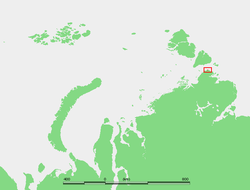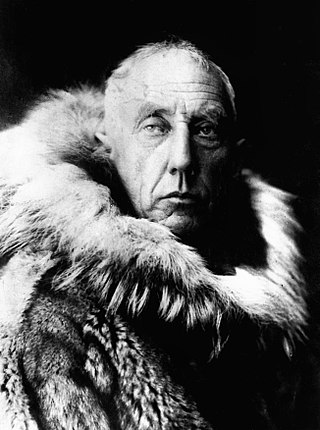
Roald Engelbregt Gravning Amundsen was a Norwegian explorer of polar regions. He was a key figure of the period known as the Heroic Age of Antarctic Exploration.

Dikson Island, initially Dickson, is the name of an island in Taymyrsky Dolgano-Nenetsky District, Krasnoyarsk Krai, Russia, situated in the Kara Sea near the mouth of the Yenisei River. A nearby urban-type settlement of Dikson, which functions as a port and hydrometeorological centre, is located on the mainland across from the island. It is served by the Dikson Airport.

Cape Chelyuskin is the northernmost point of the Eurasian continent, and the northernmost point of mainland Russia. It is situated at the tip of the Taymyr Peninsula, south of Severnaya Zemlya archipelago, in Krasnoyarsk Krai, Russia. The headland has a 17-metre-high (56 ft) light on a framework tower.
Nikolay Nikolayevich Urvantsev was a Soviet geologist and explorer. He was born in the town of Lukoyanov in the Lukoyanovsky Uyezd of the Nizhny Novgorod Governorate of the Russian Empire to the family of a merchant. He graduated from the Tomsk Engineering Institute in 1918.
William Barr is a Scottish historian with a specific interest in the history of exploration of the Arctic, and to a lesser degree, the Antarctic. He holds degrees in Geography from the University of Aberdeen, Scotland and McGill University, Montreal, Canada. From 1968 until 1999 he was a member of the faculty of the Department of Geography, University of Saskatchewan, Saskatoon, Canada and is now a professor emeritus there.
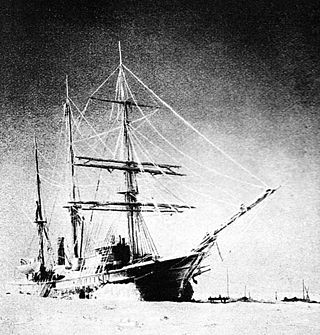
Zarya was a steam- and sail-powered brig used by the Russian Academy of Sciences for a polar exploration during 1900–1903.

Sverdrup Island is an isolated Russian island in the southern region of the Kara Sea.

Nikifor Alekseevich Begichev (Bigichev) (Russian: Никифор Алексеевич Бегичев (Бигичев); February 7 (N.S. February 19), 1874 – May 18, 1927) was a Soviet seaman and polar explorer. He was twice awarded gold medals by the Russian Academy of Sciences

The Minina Skerries are located in the Kara Sea, in the northwestern shores of Siberia. They stretch between the Mikhailov Peninsula and the mouths of the river Pyasina. Their latitude is between 74° and 75° N, and their longitude between 84° and 87° 30' E.

The Mikhailov Peninsula is a small peninsula in the eastern shores of the Kara Sea on the western side of the Taymyr Peninsula. Its latitude is 75° 05' N and its longitude 87° 15' E.

Taymyr was an icebreaking steamer of 1,200 tons built for the Russian Imperial Navy at Saint Petersburg in 1909. It was named after the Taymyr Peninsula.
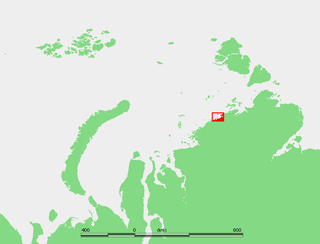
The Middendorff Bay, is a deeply indented bay in the shores of the Taymyr Peninsula. It is located southwest of the Nordenskiöld Archipelago in the Kara Sea and it is open towards the west.

The first ever expedition to reach the Geographic South Pole was led by the Norwegian explorer Roald Amundsen. He and four others arrived at the pole on 14 December 1911, five weeks ahead of a British party led by Robert Falcon Scott as part of the Terra Nova Expedition. Amundsen and his team returned safely to their base, and later heard that Scott and his four companions had died on their return journey.

Sorevnovaniya Island is an uninhabited island in the southern region of the Kara Sea. This island is located in the Sorevnovaniya Bay, east of the Mikhailov Peninsula.
The Zeledeyeva is a river in Krasnoyarsk Krai, Russia. Its source is in the Byrranga Mountains. It flows across desolate tundra regions into the Kara Sea. The Zeledeyeva freezes up in late September or early October and stays under the ice until June. It is 149 kilometres (93 mi) long.
The Uboynaya is a river in the Taymyr Peninsula, Krasnoyarsk Krai, Russian Federation. Its source is in the Byrranga Mountains. It flows across desolate tundra regions into the Kara Sea. It is 98 kilometres (61 mi) long, and has a drainage basin of 2,280 square kilometres (880 sq mi). The lichen Dactylina arctica is common and abundant in the area.

Cape Vilda is a headland in the Kara Sea, Krasnoyarsk Krai, Russian Federation. This cape is located on the western shore of the Taymyr Peninsula, at the western end of Middendorff Bay.

The Russian polar expedition of 1900–1902 was commissioned by the Saint Petersburg Academy of Sciences to study the Arctic Ocean north of New Siberian Islands and search for the legendary Sannikov Land. It was led by the Baltic German geologist and Arctic explorer Baron Eduard von Toll on the ship Zarya. Toll and his three assistants vanished in late 1902 while exploring Bennett Island. One of the key members of the expedition was Alexander Kolchak, then a young researcher and lieutenant of the Russian Navy, and later a provisional ruler of Russia during the civil war period. Kolchak also led the rescue mission to find Toll and his crew.
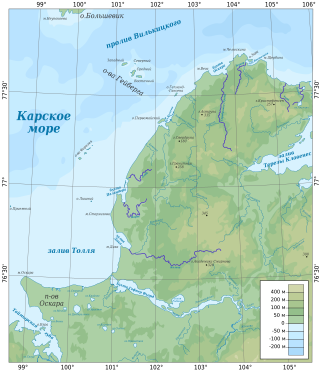
Cape Sterligov is a headland in the Kara Sea, Krasnoyarsk Krai, Russian Federation.
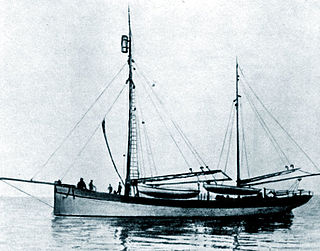
The Rusanov expedition, led by geologist Vladimir Rusanov, was a 1912 Russian expedition to the Arctic, with an initial objective of establishing mineral claims on Spitsbergen. Following completion of its official programme, Rusanov expanded the expedition's scope to include an investigation of the Northeast Passage, though it remains unclear exactly which route he proposed to take. Rusanov's ship Hercules reached Novaya Zemlya in August 1912, where he sent a message that he was continuing east; this was the last ever heard of the expedition and its 11 personnel.
